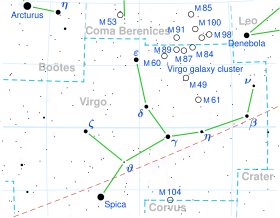Variable A-type main sequence star in the constellation Virgo
Rho Virginis (ρ Vir, ρ Virginis) is the Bayer designation for a star in the constellation Virgo. It has an apparent visual magnitude of +4.9,[2] making it a challenge to view with the naked eye from an urban area (according to the Bortle Dark-Sky Scale). The distance to this star has been measured directly using the parallax method, which places it 118.3 light-years (36.3 parsecs) away with a margin of error of about a light year.[1]
Rho Virginis is an A-type main sequence star with a stellar classification of A0 V.[3] It is larger than the Sun with a radius 60%[6] larger and about twice the mass. As such it is generating energy at a higher rate than the Sun, with a luminosity 14[6] times greater. The outer atmosphere has an effective temperature of 8,930 K,[6] which is what gives it the white-hued glow of an A-type star. It is classified as a Delta Scuti type variable star and its brightness varies by 0.02 magnitudes over periods of 0.5 to 2.4 hours.
This star has been established as a Lambda Boötis star that displays low abundances of iron peak elements. It displays an excess of infrared emission, but it is unclear whether this is being caused by a circumstellar debris disk or from the star passing through and heating up a diffuse interstellar dust cloud. Most likely it is the former,[6] in which case the dusty disk has a radius of around 37 AU and a mean temperature of 90 K.[9]
References
- ^ a b c d e f van Leeuwen, F. (November 2007). "Validation of the new Hipparcos reduction". Astronomy and Astrophysics. 474 (2): 653–664. arXiv:0708.1752. Bibcode:2007A&A...474..653V. doi:10.1051/0004-6361:20078357. S2CID 18759600.
- ^ a b c Wielen, R.; et al. (1999), "Sixth Catalogue of Fundamental Stars (FK6). Part I. Basic fundamental stars with direct solutions", Veroeffentlichungen des Astronomischen Rechen-Instituts Heidelberg, 35 (35), Astronomisches Rechen-Institut Heidelberg: 1, Bibcode:1999VeARI..35....1W.
- ^ a b Cowley, A.; et al. (April 1969), "A study of the bright A stars. I. A catalogue of spectral classifications", Astronomical Journal, 74: 375–406, Bibcode:1969AJ.....74..375C, doi:10.1086/110819.
- ^ a b Johnson, H. L.; et al. (1966), "UBVRIJKL photometry of the bright stars", Communications of the Lunar and Planetary Laboratory, 4 (99): 99, Bibcode:1966CoLPL...4...99J.
- ^ Paunzen, E.; et al. (November 2002), "The status of Galactic field λ Bootis stars in the post-Hipparcos era", Monthly Notices of the Royal Astronomical Society, 336 (3): 1030–1042, arXiv:astro-ph/0207488, Bibcode:2002MNRAS.336.1030P, doi:10.1046/j.1365-8711.2002.05865.x, S2CID 2389489.
- ^ a b c d e f g h Martínez-Galarza, J. R.; et al. (March 2009), "Infrared Emission by Dust Around λ Bootis Stars: Debris Disks or Thermally Emitting Nebulae?", The Astrophysical Journal, 694 (1): 165–173, arXiv:0812.2198, Bibcode:2009ApJ...694..165M, doi:10.1088/0004-637X/694/1/165, S2CID 14298654.
- ^ a b Sturenburg, S. (September 1993), "Abundance Analysis of Lambda-Bootis Stars", Astronomy and Astrophysics, 277 (1): 139, Bibcode:1993A&A...277..139S.
- ^ Royer, F.; Zorec, J.; Gómez, A. E. (February 2007), "Rotational velocities of A-type stars. III. Velocity distributions", Astronomy and Astrophysics, 463 (2): 671–682, arXiv:astro-ph/0610785, Bibcode:2007A&A...463..671R, doi:10.1051/0004-6361:20065224, S2CID 18475298.
- ^ Zuckerman, B.; Song, Inseok (March 2004), "Dusty Debris Disks as Signposts of Planets: Implications for Spitzer Space Telescope", The Astrophysical Journal, 603 (2): 738–743, arXiv:astro-ph/0311546, Bibcode:2004ApJ...603..738Z, doi:10.1086/381700, S2CID 3456817.


 Category
Category










